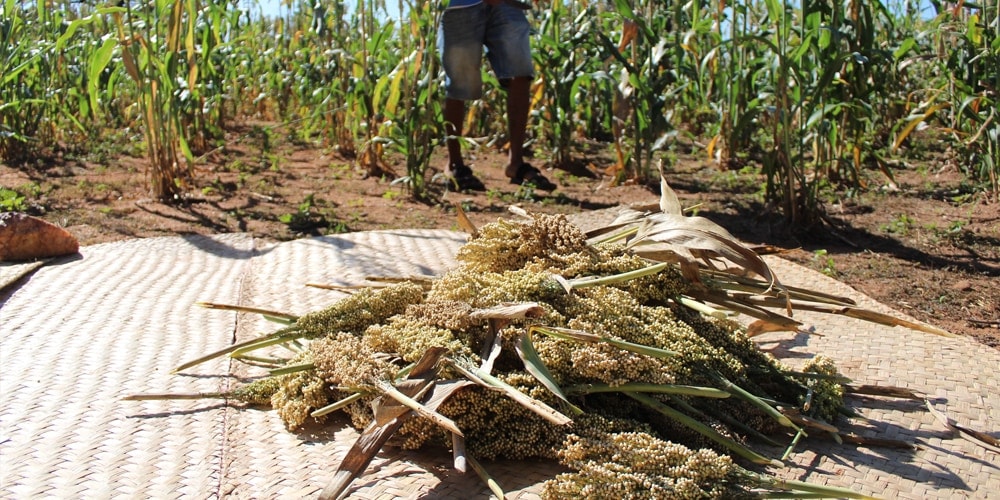
Since 2015, the Adventist Development and Relief Agency (ADRA), in partnership with the United States Agency for International Development (USAID), has implemented a food project in the Bekily, Ampanihy, and Betioky Sud districts of southern Madagascar, which have been affected by severe drought and widespread crop failure.
“The focus of ADRA’s agricultural activities was to minimize the negative effects of persistent drought on food production in the region,” Emanuel da Costa, ADRA’s program manager, said. “These agricultural activities promote drought-tolerant crops, crop diversification, and conservation of farming practices. As part of our strategy, we sought to mitigate heavy maize crop losses by reintroducing sorghum, a much more drought-tolerant crop.”
Sorghum is an ancient cereal grain that grows as tall as corn and is drought resistant; it doesn’t require much water to grow. It can be ground into flour and can also be used as livestock feed. It is gluten free, can be substituted for wheat flour, and is reportedly packed with nutritional benefits.
In southern Madagascar, successive drought cycles have led to widespread crop failures. Such failures disproportionately affect chronically underserved communities whose primary source of food and income is farming.
“Given the consistent, recurrent nature of the drought cycle, the region cannot recover from one cycle before the onset of a new one, worsening and extending recovery from subsequent shocks. In addition, the rainy season has shifted by more than two months, from the onset in September to onset in November, with poor distribution and lower overall rainfall,” da Costa said.
As a result, ADRA found that crop yields for maize, cassava, and rice dropped by 95 percent between 2015 and 2016 in the south. This reduction in crop yield left nearly 50 percent of the population in southern Madagascar, approximately 845,000 people, in urgent need of humanitarian assistance.
ADRA began implementation of the food project in four stages, targeting drought-affected households for four years. ADRA also implemented projects that included water, hygiene, and sanitation.
During the first year of implementation, ADRA focused on promoting drought-tolerant food crops like maize, cassava, sweet potatoes, and cowpeas. However, drought led to severe crop losses, especially for maize, estimated at 70 percent of the crop.
“We decided to shift from maize and work to reintroduce sorghum to farmers in the region. Sorghum exhibits tolerance for high temperatures. Its root system is twice as deep as maize; it can more efficiently retain soil moisture and use 50 percent less water compared to other cereals,” da Costa said.
Upon further study, ADRA learned that even with awareness about sorghum’s benefits, farmers had no knowledge of growing sorghum and believed that the grain reduced soil fertility and prevented adequate rainfall.
ADRA addressed these concerns by sensitizing communities and community leaders on the productivity and nutritional benefits of sorghum and by addressing the myths and misconceptions around sorghum production. The agency helped improve practices at each stage of production, from land preparation through harvest, and organized beneficiaries into farmer groups under a network of lead farmers to improve the sharing of technical information. ADRA also distributed sorghum seeds and other agricultural tools to beneficiaries and conducted cooking demonstrations that showcased the nutritional value of sorghum and how to prepare it.
By the fourth year of the project’s implementation, ADRA connected with nearly 30,000 households to adopt sorghum as a food crop for production. A later survey of more than 200 households was conducted to see how sorghum compared to maize.
“Farmers who planted sorghum saw their [arable] land area increase from 3,040 hectares (7,512 acres) in 2016 to 7,526 hectares (18,597 acres) by 2019. We began seeing an upward trend in the number of farmers planting sorghum, the average number of hectares planted, and annual yields,” da Costa says.
Da Costa added that according to survey participants, sorghum was found to be more hardy than maize and was able to withstand drought conditions longer without withering or dying, and still produced higher yields than maize.
Survey participants also reported it was easier to cultivate sorghum and that the grain does not depend on high-quality soil for production.
Households that used sorghum could prepare porridge for breakfast for their families, a whole-grain substitute for rice, and some families pound the grain into flour to make bread and biscuits. Children also found the meals very tasty, according to the findings.
“One major lesson we learned from this study is that from the start of a crisis, choosing how to react is a choice. The farmers who were so accustomed to yielding maize didn’t think it was possible to yield crops from sorghum efficiently, but when they learned that it could be done and they tried it, their mindset shifted,” da Costa said.
ADRA’s implementation of sorghum in southern Madagascar significantly strengthened the local community and farmers’ view on a tiny grain.
“Sorghum truly made a difference; it may even be a significant help for further good in this world,” da Costa said.
The original version of this story was posted by the Adventist Development and Relief Agency.